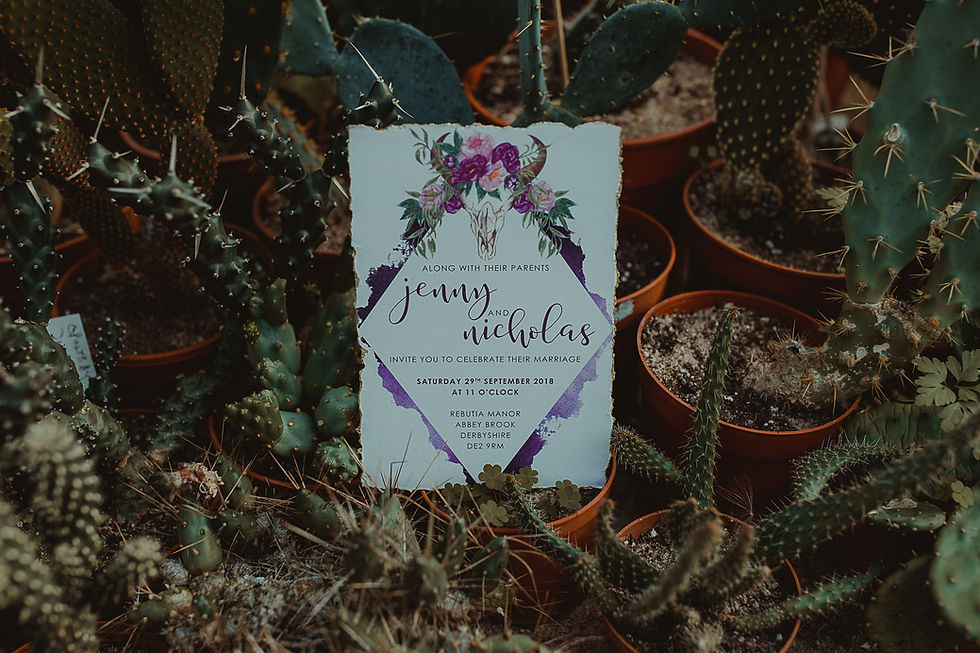How to Word Your Wedding Invitations
- Lorna Boyer

- Sep 19, 2018
- 3 min read
Stuck when it comes to how to word your wedding invitations? Wedding experts and online directory Guides for Brides have come up with a handy guide to make sure you nail your wedding invitation wording...
Your wedding invitation should cover the following:
* The location, date and time of the wedding
* The bride and groom’s names
* Who you’re inviting and any plus ones
* Whether they’re invited to the day or evening
* The RSVP deadline and how guests can reply
If you’re holding a more formal event, you may want to include wording to indicate who is hosting the wedding, and any dress code information.

Who’s hosting?
In the traditional sense, the hosts of the wedding are the people paying for it. If, for example, the bride’s parents are footing the bill, then traditional wording would be:
‘Mr and Mrs John Smith request the pleasure of your company at the marriage of their daughter, Jane, to Mr Joe Bloggs.’
If your parents are divorced, then they can be listed separately, e.g. ‘Mr John Smith and Mrs Sarah Jones request the pleasure…’
If both parents are chipping in, or you’re paying for the wedding yourself, then you can make this wording more broad:
‘Together with their families, Miss Jane Smith and Mr Joe Bloggs request the pleasure…’
Alternatives to ‘request the pleasure of your company’ include ‘request the honour of your presence’ (usually reserved for church weddings), ‘would love for you to join them’ or ‘invite you to celebrate with them’.
The bride and groom’s names
Traditionally, the bride’s name would be listed first, and then the groom’s. If the bride’s parents are hosting, then the bride would be referred to by her first and middle names.
If you’re part of a same-sex couple, or you just feel like mixing things up, then list names alphabetically.

Location, date and time
Make sure you include both the ceremony and reception venues on the invitation - if they’re being held in the same place, then simply add ‘Reception to follow’ after the ceremony time.
Traditionally, the address of the venues isn’t included, just the names and the county, but we recommend including the full address somewhere on the wedding website or on a separate card.
When it comes to the date and time, numbers are usually spelled out in full - even for the year. So, ‘Saturday 15th June 2019 at 1.30pm’ becomes ‘Saturday, the fifteenth of June, two thousand and nineteen at one thirty in the afternoon.’ You may want to amend this if you’re short of room on your invitations
Evening invitations
It should be very clear from your invitation whether the guests invited are invited to the ceremony, or just the evening reception. Your evening invitations should have an amended time, e.g. ‘Saturday, the fifteenth of June, two thousand and nineteen at seven o’clock in the evening’, and you may want to change the invitation wording to ‘Miss Jane Smith and Mr Joe Bloggs would love for you to join them at an evening reception to celebrate their marriage.’

Who’s invited?
You should name each invitee on the invitation, including children - if you’re not sure of children’s names, then write ‘and family’. If you’re giving a guest a plus one, then you should format it as ‘Mr James Green and guest’.
RSVPs
Make sure to put an RSVP deadline on the invitation, and either let them know an address to send their RSVP card back to, or a wedding website where they can respond digitally. It’s up to you (and the wedding budget!) whether or not you pre-pay any RSVP cards. One easy way to track your RSVPs is to use an online tool like the Guides for Brides online wedding planner, which keeps your guest list details all in one place. You’ll be able to track who’s invited to the day and evening, what their dietary requirements are, and whether they’ve RSVP’d. Handy!

For more wedding tips and inspiration, visit guidesforbrides.co.uk.
Photos by Birches & Pine Wedding Photography and Rachel Henson








Comments